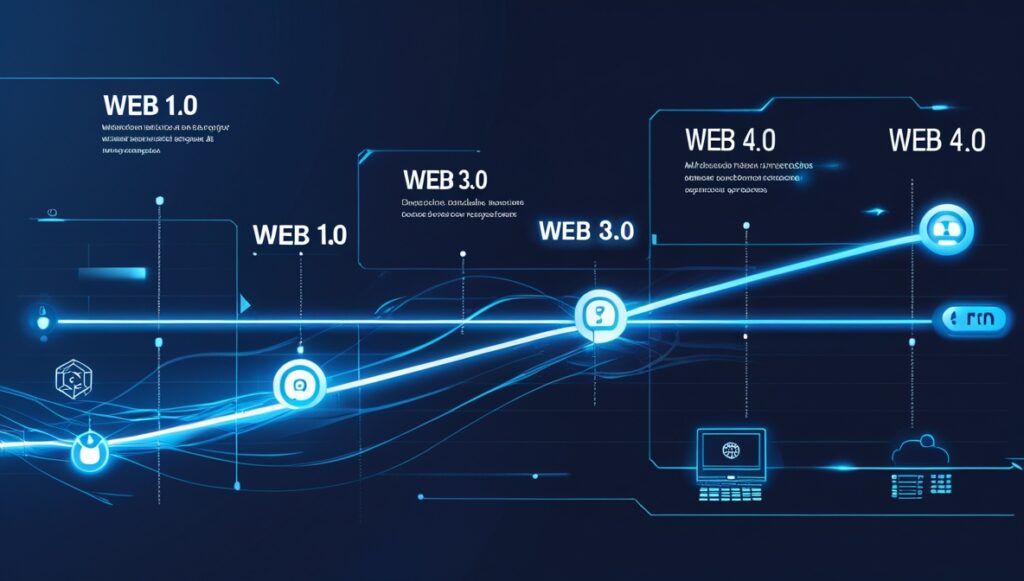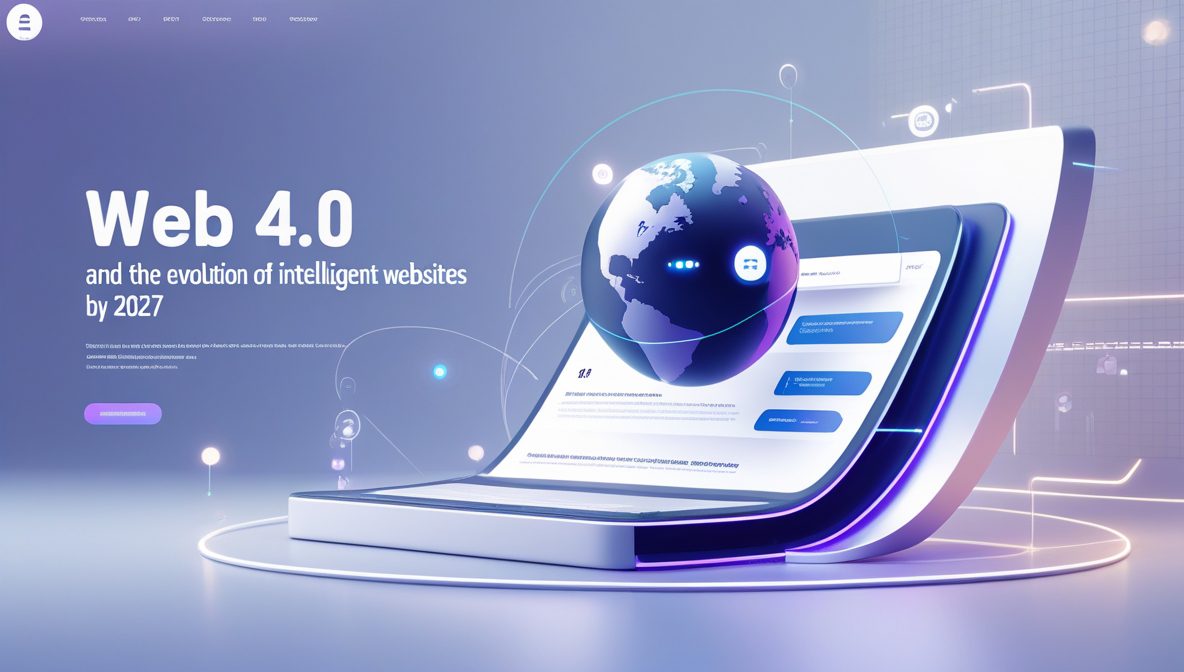Webpages on the internet have grown from being nothing more than online information, to social websites that people can interact on. Now, a new phase is approaching — Web 4.0. This new generation of the web is driven by systems that can learn on their own, adapt and react in real time. It mixes AI, our personal data, advanced computer talking and natural interactions into the websites and applications we use daily.
Because of rapid changes in technology, websites now serve different purposes besides browse or pay for things. One trait is that they learn a lot about their users, suggest logical choices and sometimes act on their own. As we move closer to 2027, Web 4.0 is expected to play a major role in reshaping how websites function, how users interact with them, and how businesses deliver digital experiences.
What Sets Web 4.0 Apart from Earlier Generations

The web has gone through many changes in how people interact with it and what technology they use. Web 3.0, Web 2.0 and Web 1.0 all grew out of what came before them. Web 4.0 is now aiming to connect Everything — devices, systems, and users — in real-time with minimal friction and maximum intelligence.
What makes Web 4.0 stand out is its deep integration of AI and machine learning, combined with predictive automation. There’s more to it than just recycling content that users find appealing; we aim to learn about actions, surroundings and feelings to help make the experience worthwhile and fruitful. Those websites are now more than tools; they have become smart helpers.
From Static to Smart Interfaces
Older websites simply presented information. Interaction between users advanced, thanks to Web 2.0, through options to share and communicate. Then followed Web 3.0, introducing organized data, personalization and the basis for machines to understand information. Now, Web 4.0 is adding a new layer — intelligence. This leads to websites acting proactively instead of only reacting. they are going to think, make predictions and adjust to their environment.
With smart interfaces, businesses now use AI chatbots, respond to commands through voice assistants and offer real-time customization. A person looking at a product page can receive recommendations now, considering not only past purchases but also the time and place. That kind of proactive design is what Web 4.0 is making possible.
Real-Time Learning and User Adaptation
Websites built with Web 4.0 principles will continuously learn and evolve. Users might experience search engines differently. In this way, every visit is specially designed to meet a patient’s habits, goals and preferences. This can be done with live data analysis and by automatically adjusting what is delivered to users. Because of this, websites stay active and useful, even after initial development. If a guest is back again or just coming for the first time, the system understands what to do and how to interact.
Machine-to-Machine Communication Across Platforms
A core aspect of Web 4.0 is that devices and websites will communicate with each other without user involvement. Therefore, a smart refrigerator may order milk automatically from a grocery website and a wearable device could reveal health data on a wellness website by itself.
The goal of machine-to-machine interactions is to make life easier for users. They simplify tasks and ensure systems can respond to changes fast. As these systems become better, companies will be capable of automating services without losing the human touch.
The Role of Artificial Intelligence in Web 4.0

Artificial intelligence is at the heart of Web 4.0, enabling websites to become more intelligent, predictive, and responsive. Although some websites have similar AI features today such as search filters or chatbots, the future promises even stronger uses that will transform the whole experience for users.
Online platforms will offer advice, handle routine activities and change their layout according to how users engage with them. AI will adjust websites so that content and suggestions stay fresh, making them respond to users in the moment.
Personalized Experiences at a New Level
The point is not only to suggest a product but also to recognize what the user wants. With Web 4.0, websites will analyze behavior, timing, past actions, and even device usage to deliver personalized journeys. If a person likes to use Piggy at night, the screen could change to darker settings. Sometimes, if a user does not look at tutorial pop-ups, the site could eventually remove them.
When personalization is as high as it is, users are more likely to trust the platform and come back regularly. Instead of users being required to change, the system is designed to adapt, making everything easier and more enjoyable.
AI-Driven Content and Decision Automation
Businesses are already using AI to generate product descriptions or run customer support bots, but Web 4.0 will take this to the next level. AI will take over making content, choosing actions and guiding customers, freeing humans from many roles. If a user leaves a form partially complete, the system may offer to simplify it or carry out the rest for them. There will not be strict rules set for making these decisions. They will use up-to-date data, projections and ongoing learning.
Smart Search and Contextual Responses
With traditional search tools, people have to provide exact keywords they are searching for. But with Web 4.0, search will feel more like asking a question in a natural conversation. Vague or complex question will be understood by AI and the results returned will consider what the user is interested in and has recently done.
Should someone enter “I want something light for dinner,” the site could present recipes as well as food delivery possibilities, looking at previous and current circumstances. This type of response is the goal for AI-powered websites.
How Web 4.0 Will Impact Businesses and Digital Platforms

Businesses that adapt to Web 4.0 will gain a strong edge over those still using traditional website structures. Companies using smart technology can offer better service, make users happier and provide more value while working efficiently. Being smart is more important than just having a modern look.
Web platforms will become better at handling tasks that were once carried out by large teams. Processes like customer care, advice on products and user registration will be handled with greater accuracy and more people can be assisted by intelligent systems. This allows businesses to increase their size without overpaying.
Smarter Customer Service and Support
Support channels powered by Web 4.0 will go far beyond basic chatbots. Each customer will be understood, with the systems recognizing their past orders, any issues raised, what they like and even their current mood before helping them. If someone has been a customer before, the details can be placed on file. The system has the ability to understand and take action based on your needs. As a result, people can interact better and solve problems more quickly. This makes it possible for companies to deliver personalized support at all times, even with limitation to certain agents. This approach helps customers get support more quickly and be more satisfied.
Improved Conversion Rates Through Prediction
With predictive algorithms, websites can help users reach their preferred results more effectively. Whether the goal is a sale, a subscription, or filling out a contact form, Web 4.0 will help users get there more easily by anticipating what they need next. As an example, if someone is looking at various prices, the system can offer a discount to encourage them to stay on the website. By taking these actions, websites can expect more people to purchase and keep more users on the site.
Business Dashboards with Real-Time Insights
Back-end systems will also improve. With Web 4.0, website dashboards can update in real-time, providing immediate insights into traffic patterns, behavior changes, and campaign results. Real-time data allows teams to make quick changes, rather than delay until the end of the day. Businesses can achieve many benefits from working quickly. They can try out new approaches along the way which boosts success and does not waste important resources.
What to Expect from Web 4.0 Websites by 2027

By 2027, Web 4.0 websites will no longer be just destinations. They will continue to progress and adapt to provide better service for the user. The genuine nature of these websites enables them to think, predict, adapt and talk to you just like a real assistant. AI making things happen and fresh real-time data making it all come alive, today’s digital environments won’t hold a candle to what we’ll be using in the future.
A good design and quick performance will be expected in addition to other benefits. Users will expect websites to be aware of their needs, to save time and to solve issues with little work from their end. Businesses that start building with Web 4.0 principles today will be ready for that shift and ahead of those who wait.
An Intelligent Personal Dashboard for Every User
Online portals will begin to collect information and arrange it according to the likes and habits of users. No matter if the website is for eCommerce, learning or finance, users can find the information they need quickly. Showing content in a unique way benefits the user and helps them feel more attached to the platform.
Voice-Activated and Natural Interactions
By 2027, website navigation involving voice will be a built-in function for many. People will often use their voices instead of typing or clicking. This proves to be valuable for mobile or wearable devices. Such natural interactions will break down some of the barriers and lead to smoother online experiences for all. With time, static menus and buttons on websites will seem old-fashioned. It is important to design with voice and natural language in mind to succeed in the future.
Automatic Adaptation to Device and Environment
Websites built on Web 4.0 principles will be highly responsive — not just in layout, but in behavior. Smart TV users and phone users might see distinct content because what they aim to do on each device is different. It may also change depending on the speed of your internet, the time it is being used or your location. Thanks to these changes, the web seems more human and less robotic. It means interactions with your devices become smoother and more intelligent as time goes by.
Final Thoughts: Building for the Web 4.0 Future
The shift toward Web 4.0 is already happening. Since AI, predictive technology and smart interfaces are now commonly used, businesses should prepare their websites for future needs. Intelligent websites are now required, instead of being considered luxuries. As we approach 2027, the way we interact with the web will feel very different. It will be faster, more personal, and far more useful. Those who embrace this transformation early will not only meet user expectations but also set new benchmarks for what a website can be.

